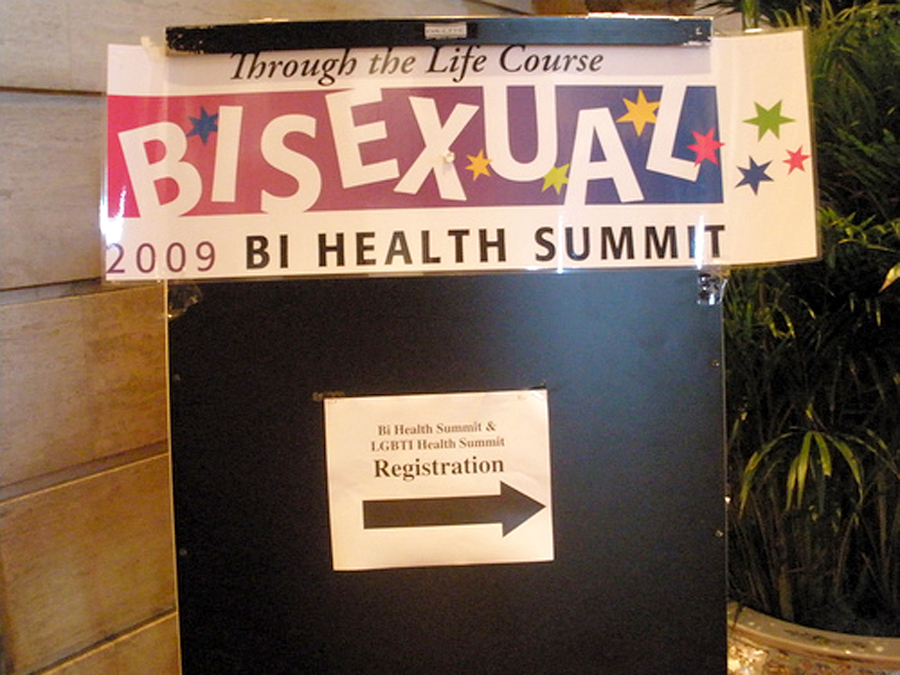By Julie Ebin
The 2009 Bi Health Summit was a one-day pre-conference institute (and preceding evening reception) to the 2009 National LGBTI Health Summit, which addressed bisexual health concerns and those of non-bi-identified multi-sexual women and men. It was held in Chicago, IL on August 13 and 14, and attended by about 65 people.
The organizing committee included two Boston bi women: Jen Bonardi (Co-Chair) and Julie Ebin (Co-Chair), and three others: Luigi Ferrer (Miami, FL/Co-Chair), Stewart Landers (Boston, MA) and Ed Negron (Chicago, IL).
Our activities included bisexual and bi ally visibility efforts at the Bi Health Summit and the LGBTI Health Summit, including a reporting-back on the Bi Health Summit at one of the LGBTI Health Summit plenaries, the self-selecting use of “Bi” and “Bi Ally” stickers on registrants’ name tags, educational materials about recognizing and reducing biphobia and about the bisexual flag, and the noticeable presence of Bi Health Summit tee-shirts at the LGBTI Health Summit.
I opened the Bi Health Summit by thanking the organizers of the Bi Health Summit and the organizers of the LGBTI Summit for helping to make this happen. Cheryl Dobinson delivered her keynote address “Top Ten Bisexual Health Issues: What Current Research Tells Us.” Stewart Landers also presented data on bisexuality and health in Massachusetts. A key point is that we now know more about our community through population-based surveys, including the fact that among lesbians, gay men and bisexuals, there are as many people who identify as bisexual as there are people who identify as lesbian and gay combined. Put another way, of those who identify as lesbian, gay or bi, 50% identify as bi. Further, among bisexuals, this is roughly 2/3 female and 1/3 male and among lesbians/gay men the ratio is reversed – 2/3 male and 1/3 female. (Apologies to transgender people who identify outside of a gender binary and to people who use other sexual identity terms, such as queer. The research producing these statistics looks only at four common sexual identity terms [straight, bisexual, gay and lesbian], and summarizes findings based on female and male genders). This 50% statistic is an important piece of information that is now becoming more commonly acknowledged among researchers and needs to be disseminated more widely.
A small but growing body of research comparing the health of bisexuals, lesbians and gays, and heterosexuals suggests that bisexuals have worse outcomes than monosexual groups in several areas including alcoholism, drug use, depression and other mental illness, smoking, suicide ideation and violence victimization. The important take-home message is that researchers should do all they can to consider bisexuals as distinct from lesbians/gays in their analyses, so we can continue to learn more about differences among the sexual orientations.
Presentation topics ranged from bisexual health disparities, educating health providers about bisexual health, the need for bi-inclusive HIV awareness campaigns, bisexual inclusion in student LGBT groups at a health professions school, bisexual mental health and stigma in women and in African American men, a performance piece and training on bisexual men of color, and a train-the-trainer session on a curriculum-based bisexual support group.
At the end of the Summit and via the bisexual caucus, there were several individuals and group commitments to next steps. One goal is to establish a definition of Bisexual Health. Another committed to continue her work as a trainer and public speaker on Bisexual Health. A third was to have as many of us as possible sign up for the Bi Health Group on Yahoo. To sign up, go to Yahoo groups and search for “BiHealth,” or send an email to BiHealth@yahoogroups.com.
Finally there was discussion about including the next Bi Health Summit as part of the next LGBTI Health Summit in 2011. People agreed with this. It was also suggested that more lesbian and gay health events be infused with substantial bisexual content. There was also a strong voice in the final session to make the Bi Health Summit more trans-inclusive. One suggestion, to address and treat people holistically, may be what is needed to improve awareness of bisexual health issues and be respectful of each person’s identity. As a result of the LGBTI Summit plenary report-back, there was a suggestion to include in future efforts more discussion of bisexual community strengths and positive health actions instead of focusing only on problems and deficits.
Presentations, bios, the Summit schedule, videos and pictures can be accessed at: www.2009lgbtihealth.org/content/page/bi-health-summit. Many of the materials from the Bi Health Summit are also archived on the BiHealth yahoogroup.
Folks who are interested in working on a future bisexual health summit may want to start preliminary work with the 2011 LGBTI Health Summit (Portland, OR) as a possible vehicle for collaboration. Information about the 2011 LGBTI Health Summit is available at www.2009lgbtihealth.org/content/page/2009-national-lgbti-health-summit.

